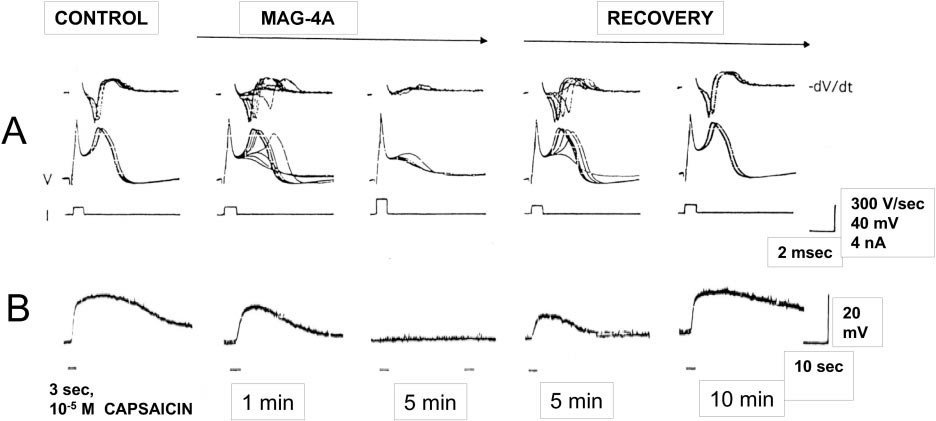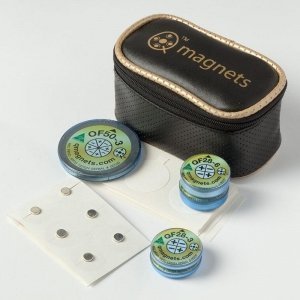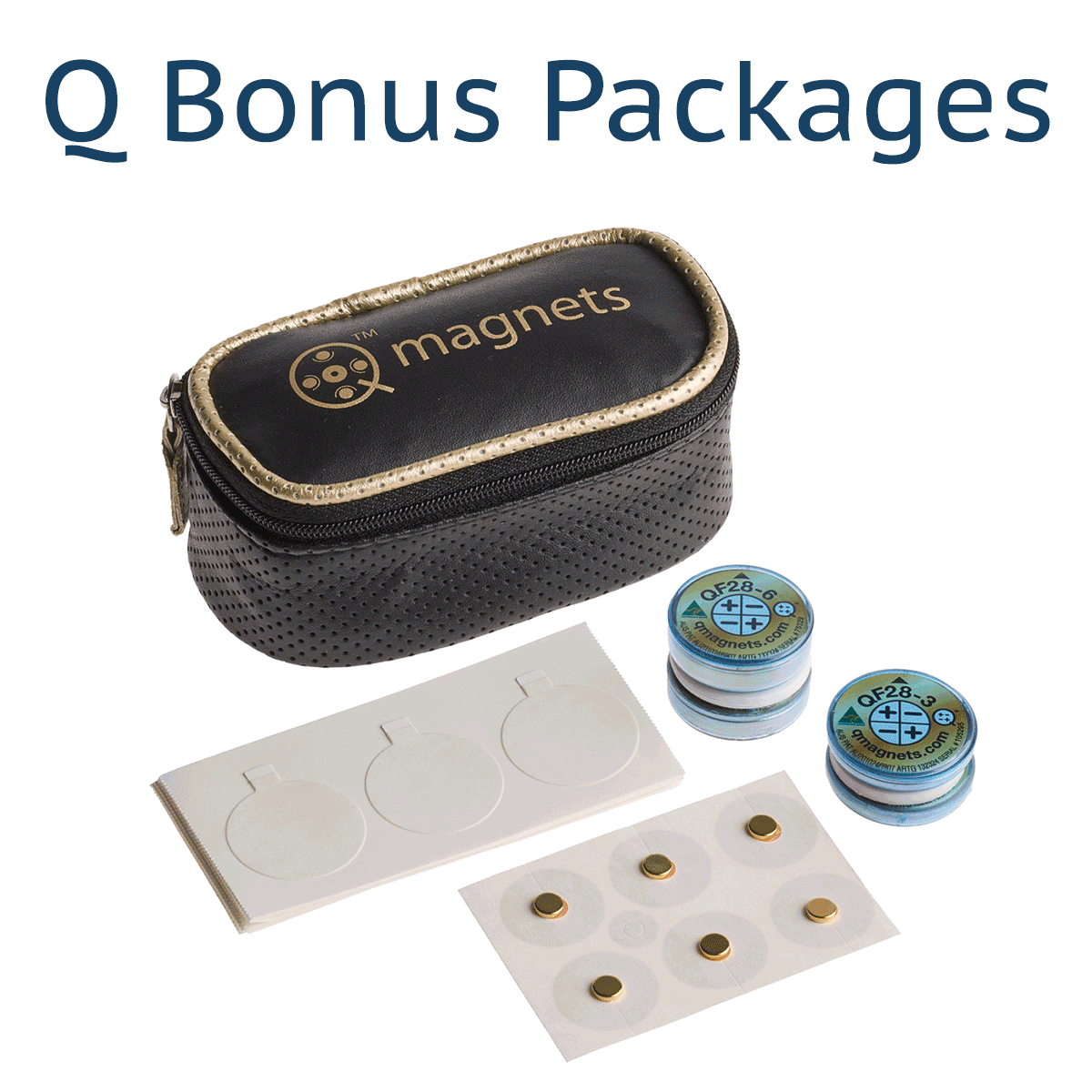Pain signals are transmitted by tiny electromagnetic pulses via the nervous system. Over the years, researchers have proposed many mechanisms for how static magnets might effect nerve cells (neurons) in a way that has therapeutic value.
Some suggestions like magnets attracting iron in the blood are just plain wrong. We have provided a theory of how Q Magnets might alleviate pain here, the basis being changes to Sodium (Na+) and Calcium (Ca2+) ions permeability across the cell membrane. The flow of Na+ and Ca2+ ions through gates within the nerve cell membrane are how these tiny electromagnetic pulses, called Action Potentials reach threshold voltage in order to discharge. The action potential is the fundamental pulse of the nervous system.
The theory of how Quadrapolar magnets provide pain relief goes like this…
- Neurons playing a role in chronic pain may have “leaky” ion gates, lowering their threshold for action potential firing.
- The influence of the unique Quadrapolar magnet field closes the leaking gates.
- Abnormally firing nerves can now function in a state of rest.
- The magnetic field only seems to affect nerves that are firing abnormally.
- If the abnormal nerve signal does not reach the brain, then pain is not perceived.
The image below are experimental results of a published study showing the action potential blockade while under the influence of the magnetic field from a Quadrapolar magnet. Each action potential image (top row) shows several traces superimposed from the same neuron at different times. You can see a video of the researchers conducting the experiment here.
 Action Potential Blockade at Maximally Effective Region (MER) of Quadrapolar magnet 5mm from surface. From McLean et al (2001) REF 2.
Action Potential Blockade at Maximally Effective Region (MER) of Quadrapolar magnet 5mm from surface. From McLean et al (2001) REF 2.
A new study (REF 1 see bottom of page) out of Iran University of Science and Technology by Hashemi & Abdolali uses physics, modelling and simulation to cleverly evaluate four possible mechanisms.
This three-dimensional analysis and modelling of Static Magnetic Fields (SMF) and their effects on neurons, may be very useful in identifying which mechanisms are worthy of further investigation. There are four main theories as to how SMF might affect nerve cells.
Possible Mechanisms For Magnetic Fields Affecting Neurons:
- A force exerted on moving charged particles. Since the flow of ions such as Sodium (Na+), Calcium (Ca2+) and Potassium (K+) are the basis of nerve conduction and, by definition a SMF exerts a force on a moving charged particle. It is feasible that SMF could interfere with this process.
- These Na+, Ca2+ and K+ ions have to move through gates or channels within the cell membrane. The gates consist of a molecular arrangement, e.g. proteins that can experience a torque force while in the presence of a SMF. These channels could rotate within the membrane wall and alter its permeability to the flow of ions.
- Ions can be paramagnetic or diamagnetic and are thus exposed to forces when in the presence of magnetic field gradients.
- Other diamagnetic particles within the cell membrane (with anisotropic properties) will experience a torque (twisting) force while in the presence of a SMF.
An Example For The Physics Fans:
Mechanism 1 is an example of magnetophoresis, which is simply motion induced on a particle while under the influence of SMF. Imagine a sodium ion (Na+) moving through a cell membrane; it experiences what’s called a Lorentz Force according to the formula…F = qE + qvB
Where F is the Force, q the charge on a Na+ ion, E the electric field, v the velocity of the Na+ ion and B the magnetic field. The formula shows the force has an electric field component E and a magnetic field component B. Once the values are set, it’s simply a matter of plugging them into the formulas to estimate the forces.
NB: In reality, it’s a little more complicated, but will suffice for the example.It turns out that the force exerted by the natural electric field across the cell membrane is around 10-11 Newton, while from the applied magnetic field 10-22 N. This is a difference of 109 N!
In simple language, the force exerted on these charges moving through the membrane from the applied magnetic field are one billionth of those that occur naturally from the electric field. Hence it’s not unreasonable to eliminate this theory as a possible mechanism for how SMF might affect the nervous system.
 It’s complicated…Formula proposed by Hashemi & Abdolali for calculating the magnetic force on a nerve membrane.
It’s complicated…Formula proposed by Hashemi & Abdolali for calculating the magnetic force on a nerve membrane.
By definition a static magnetic field will exert a force on a moving charged particle, as in an electron travelling in a particle accelerator. But, it starts to get really complicated when discussing charged particles within cell membranes in the presence of magnetic field gradients (or inhomogeneous magnetic fields). In some cases there are only torque or twisting forces while others translatory or push or pull forces. See more on magnetic field gradients here.
Suffice to say, that Hashemi & Abdolali were able to theoretically evaluate and experiment with each mechanism.
Another study (REF 3) looking at the blockade of neuron action potential firing while under a SMF from a Quadrapolar magnet found the effects were strongest after 200-250 seconds and concluded that the effect may be attributed to sodium channels for the following reasons:
- Failure was preceded often by a reduction of the maximal rate of rise, which is an indirect measure of sodium current.
- Recovery was significantly prolonged in more than half of neurons which were not stimulated during exposure to the field.
- Resting membrane potential, input resistance and chronaxie were unaffected by the field.
After many published studies, the researchers suggested that the most likely mechanism is that the Quadrapolar field is altering nerve excitability as a result of changes in membrane permeability to Na+ and Ca2+ ions (REF 3 & 4).
SUMMARY:
With regard to the first three possible mechanisms, the strength of the magnetic field required to exert a biological effect were a factor thousands if not billions stronger than what’s possible with a static magnet.
Note: Even rare earth neodymium magnets struggle to achieve a field strength of 1.3 Tesla (13,000 Gauss), while the average MRI might have a field strength of 2-3 Tesla and the Earth’s magnetic field is around 0.00005 Tesla (0.5 Gauss).
However, the fourth mechanism does show promise for a biological effect on the processes that blocks neuron action potential firing. Importantly, the values for the strength of the magnetic field are within the parameters of common rare earth magnets. Further more, they calculated that the time taken for this mechanism to take effect would be around 225 seconds. Curiously enough, this time frame almost precisely correlates with the experimental data measured in previous studies (REF 4) investigating Quadrapolar magnets blocking action potential firing.
REFERENCES:
REF 1
Hashemi, S., Abdolali, A., (2017). “Three-Dimensional Analysis, Modeling, and Simulation of the Effect of Static Magnetic Fields on Neurons.” Bioelectromagnetics 38(2): 128-136. PMID: 27862074; http://dx.doi.org/10.1002/bem.22019
REF 2
McLean, M., S. Engstrom, et al. (2001). “Static Magnetic Fields for the Treatment of Pain.” Epilepsy & Behavior 2(3): S74-S80 doi:10.1006/ebeh.2001.0211
REF 3
McLean, M. J., R. R. Holcomb, et al. (1995). “Blockade of sensory neuron action potentials by a static magnetic field in the 10 mT range.” Bioelectromagnetics 16(1): 20-32. PMID 7748200; doi:10.1002/bem.2250160108
REF 4
Cavapol et al. (1995) Measurement and analysis of static magnetic fields that block action potentials in cultured neurons. Bioelectromagnetics.1995;16(3):197-206. PMID: 7677796; doi.







